SUMMARY
This is AI generated summarization, which may have errors. For context, always refer to the full article.

(First of two parts)
The Philippine presidency has been visibly changed by the rise of Rodrigo Duterte. The changes have, in fact, been the subject of much scrutiny by Duterte supporters and oppositors, and, by non-partisan entities. A little over a year after the presidential elections in May 2016, there seems to be general consensus that Duterte is one of a kind, at least in the post-Marcos era. Nobody seems to be asking, however, if change has reached the legislative branch.
New president, not-so-new Congress
I think people are merely assuming that the Philippine Congress, as an institution, has changed because of the “supermajority” and the all-Mindanaoan leadership in both the Senate and the House of Representatives – but has it really changed? To what extent and towards what direction?
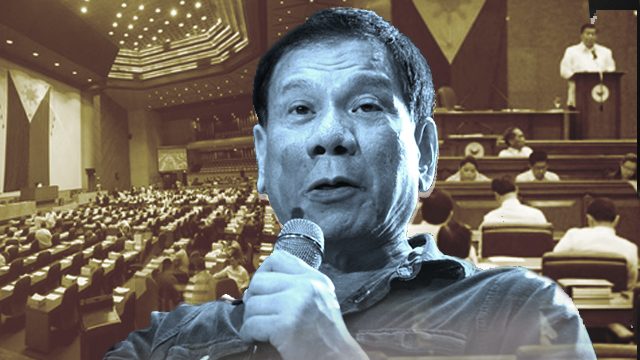
To tackle these questions, I first revisited the 2004 study of Coronel, Chua, Rimban and Cruz entitled “The Rulemakers: How the Wealthy and Well-Born Dominate Congress.”
In the study, the authors claimed: “The typical Filipino legislator is male, middle-aged, and college educated, most likely with a degree in law. He has previously held a local government post and is a member of a political family, with a sibling, father or grandfather who had been voted into public office in the past. There is one chance in two that he is related to a former legislator.”
“He is also into business and has multiple income sources. He has property for rent, earns salary from a profession, and has investments in company shares. He is well off, with a net worth (most likely understated in his statement of assets) in the P10M range. And the likelihood is that the longer he stays in Congress, the richer he becomes.”
From the data that I have gathered, I argue that the current 17th Congress essentially remains the same not just in composition but also in terms of patterns of behavior, internal dynamics, and relations with the executive branch. While there have been some shifts especially in political alliances because of the Duterte presidency, these shifts have neither eliminated nor weakened the fundamental character of the Philippine legislature. Entry is still via political families, alliances are still determined by who is the incumbent president, voting on laws is still shaped by vested interests and not ideological unities, and money still speaks. Moreover, the typical legislator is still male and middle-aged.
I further argue that when a traditional, elite-dominated Congress is combined with an authoritarian-populist president, the former loses its organizational integrity and becomes merely subservient to a strengthened presidency. Congress remains functional but its institutional character is severely diminished.
The 17th Congress, when viewed in tandem with the Duterte presidency, reveals the phenomenon of perverted pluralism (elitism) combining with perverted populism (one-man rule). Indeed, this signals “change,” albeit from bad to worse. It is not possible for the combination of two perverted systems to constitute positive change.
Data presentations in this piece are in summary form but such were culled from information regarding individual representatives and senators – sourced from official government data mostly from the websites of the House and the Commission on Elections. The Rappler research unit was most helpful in gathering data regarding the congressional representatives. A colleague at the Ateneo Political Science Department also lent assistance in researching on the senators. The points of analysis, however, are all mine. The errors, thus, are also all mine.
Perverted pluralism: the elite as ‘the people’
The current House of Representatives has a total of 297 seats, 4 of which are vacant. The Senate, meanwhile, has a total of 24 seats with only one seat vacant.
This section examines the composition of Congress in relation to the larger Philippine population it supposedly seeks to represent.
Old boys club
Based on the 2015 Census of Population, the population of the Philippines is 100,981,437. Of the 100.98 million Filipinos, 50.3 million or 49.6% are female while 51.2 million or 50.4 million are male. The gender ratio is thus more or less 50-50.
The House of Representatives, however, is male-dominated. Roughly 70% of the representatives are male and 30% are non-male. As Figure 1 below shows, of the 293 sitting representatives, 206 are male, 86 are female, and one is transgender.
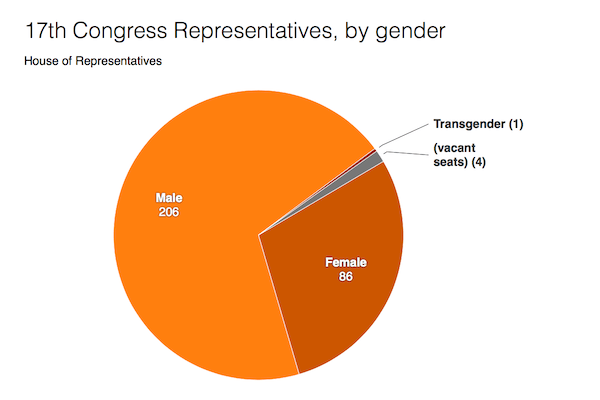
The Senate is also male-dominated. Figure 2 shows that 17 senators or 71% are male while 6 senators or 25% are female.
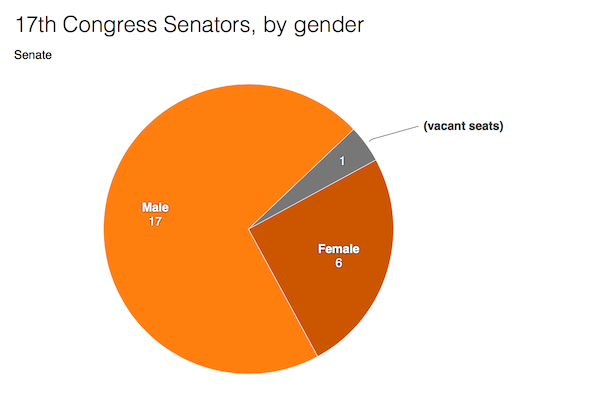
Congress is dominated not just by men but by middle-aged men as the median age of representatives is 52 years. Figure 3 below shows that while representatives in the age range of 35 to 49 years old comprise the largest percentage at 34.3%, the combined cohorts of representatives in the age range of 50-60 years old and those 60 years and above make up roughly 60% of the total number of representatives. Those who are in the 25-34 age range – those who can technically be considered as part of the “youth” sector – comprise only 4.3%.
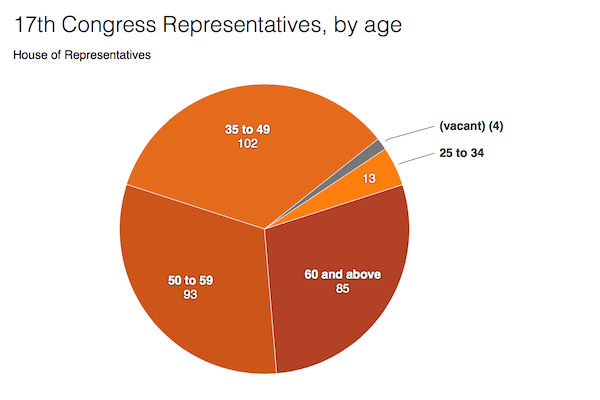
In the Senate, 46% or 11 senators are in the 35-49 age range. Meanwhile, 25% or 6 senators are in the 50-60 age range and those 60 years and above also comprise 25%. Thus, senators aged 50 and above comprise 50% of the Senate.
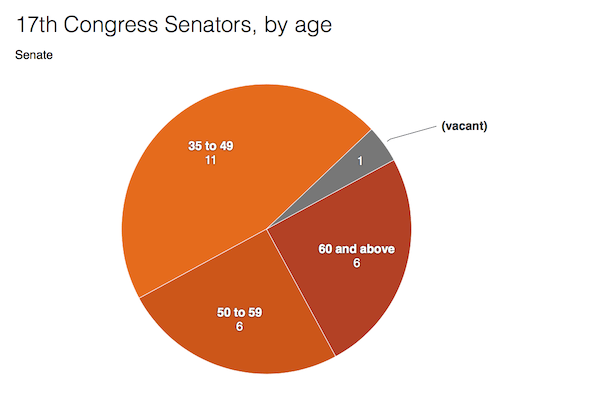
These figures are in stark contrast to what’s happening in terms of our society’s age structure. According to official statistics and as shown in Figure 5, Filipinos are relatively young. More than half of the population, 51.8 million or 51.3%, are in the age range of 0 to 24 years. Those in the 25-34 age range comprise 15.7 million or 15.5% of the population while those in the 34-50 age range comprise 17.8 million or 17.7%. Those in the 50-59 age range, meanwhile, are 8.0 million or 8.1% while those in the 60 and above age range are 7.5 million or 7.4% of the total population.
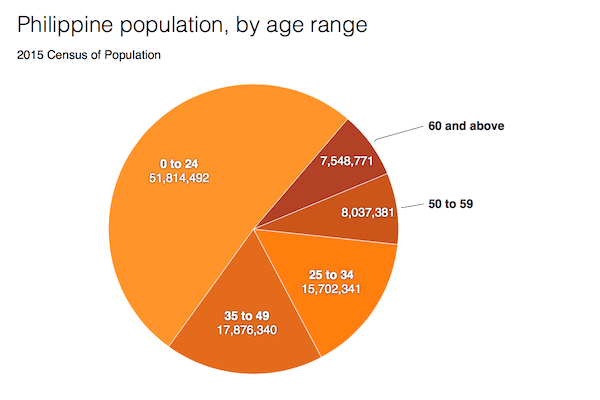
Political dynasties still dominant
Figure 6 below shows that 140 representatives or 47% are first termers. Of these, 111 representatives or 37.3% are “first termers” while 29 or 9.7% are “returning” first termers. The rest of the 153 representatives are second or third termers.
Theoretically, the presence of first termers in Congress suggests the possibility of new dynamics. New entrants are assumed to be out to prove themselves worthy to be legislators and are thus potential sources of independent ideas and critical thinking.
At first glance, the figures suggest that a new dynamic could be expected from the House of Representatives given the large number (almost half) of first termers. A closer look at the names of these first termers, however, will reveal that they are actually old timers.
Among the “returning” first termers, for example, are very familiar names and practically mainstays of Congress and/or local government units: Pantaleon Alvarez, Antonio Floirendo, Robert Ace Barbers, Prospero Pichay, Edcel Lagman, Joey Salceda, Arnulfo Fuentebella, Danilo Suarez. Even among the “first termers” (i.e first-timers in the House), there are very familiar names: Vilma Santos-Recto and Pia Cayetano.
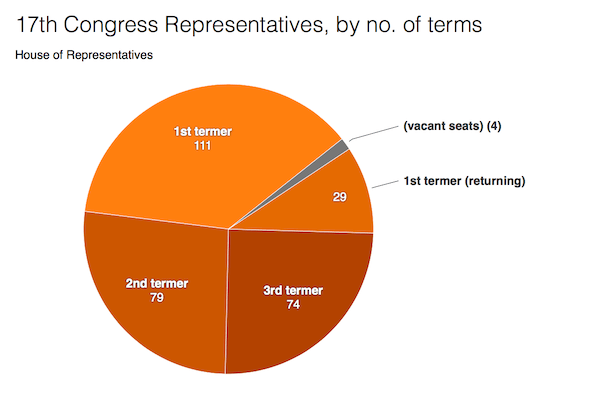
Figure 7 below shows that the 17th Congress is still dominated by political dynasties with almost 64% or 190 representatives having links to dynasties. Of the 190, 131 or 44.1% have relatives in another position, and 13.1% have had relatives who were politicians in the past.
There are 103 representatives or 34.6% who are not members of political dynasties. This seems to be an encouraging development. A closer look at the composition of this cohort, however, will show that almost 40% of the 103 are party-list representatives – which really should be the case, given that the party-list system was meant to reform the composition of the House from elite/dynastic to non-elite/non-dynastic.
The data also reveal that even among party-list representatives, there are those with relatives in political posts. Examples include Jericho Nograles of PBA who is the brother of Davao City 1st District Representative Karlo Nograles, Mariano Velarde of Buhay who succeeded his brother Rene Velarde, Emmeline Aglipay-Villar of Diwa who is the wife of incumbent congressman-turned-DPWH Secretary Mark Villar, Vini Ortega of Abono who is the wife of La Union Governor Pacoy Ortega, Anna Marie Villaraza-Suarez of Alona who is the wife of incumbent Quezon Governor David Suarez and daughter in-law of incumbent minority head Danilo Suarez, and Tricia Velasco-Catera of Mata who is the sister of Marinduque Representative Lord Allan Velasco.
The data also show that the young in Congress are not a new breed of politicians, and, in fact, represent a new generation of dynasts. Many of those who are young – below 40 years old – are members of political dynasties: Mandaluyong City Representative Alexandria Gonzales who succeeded husband Neptali Gonzales, Manila 5th District Representative Amanda Christina Bagatsing who succeeded father Amado Bagatsing, Valenzuela City 1st District Representative Wes Gatchalian who is the brother of Senator Sherwin Gatchalian, Pangasinan 4th District Representative Christopher de Venecia who succeeded mother Gina de Venecia, Quirino Representative Dakila Cua who is the son of Governor Junie Cua, Cebu 1st District Representative Gerald Anthony Gullas who succeeded Eduardo Gullas, Zamboanga del Norte 1st District Representative Seth Frederick Jalosjos who is the nephew of Dapitan Mayor Rosalina Jalosjos, Camiguin Representative Xavier Jesus Romualdo who is the son of Camiguin Governor Maria Luisa Romualdo, and Lanao del Norte 1st District Representative Mohamad Khalid Dimaporo who is the son of Lanao del Norte 2nd District Representative Abdullah Dimaporo.
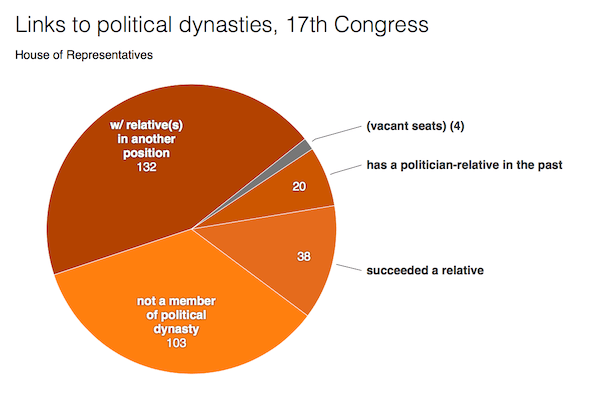
In the Senate, more than 50% of senators have links to political dynasties. Of the 24 senators, 13 have links: 8 have relative/s in another position, 5 succeeded a politician-relative. Eleven, meanwhile, have no links to dynasties.
House of millionaires
The House of Representatives, being the lair of political dynasties, is composed largely of rich people. Figure 8 below shows that there are two representatives in Congress who are billionaires and 6 who have a net worth in the range of P500 million-P999 million. Ironically, these two representatives who are billionaires – Michael Romero of 1-Pacman and Emmeline Aglipay-Villar of Diwa – are party-list representatives who are supposed to represent the “marginalized.” The figure also shows that there are only 6 representatives who are not millionaires and that 50% of the representatives have net worths in the range of P10 million-P49 million.
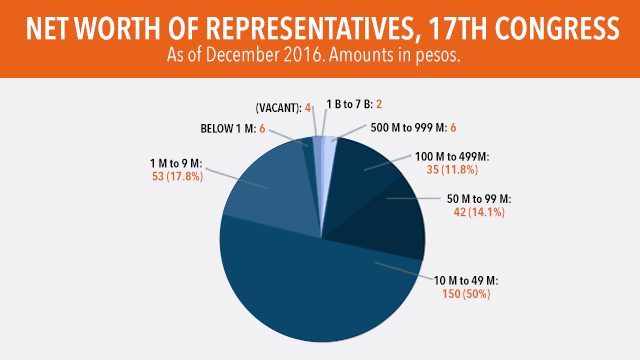
The 24-member Senate (including now Foreign Secretary Alan Peter Cayetano), meanwhile, is composed of two billionaires, 4 millionaires, and 18 multimillionaires.
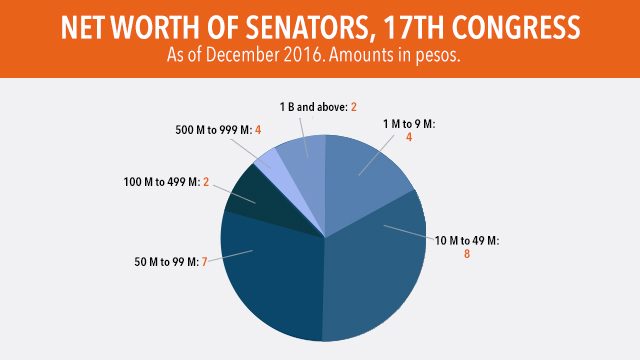
Again, the situation is in stark contrast to the larger reality. Data on the income structure of Filipino families show that the upper class – obviously dominant in the Philippine legislature – comprises only 0.21% or 21,700 families of the total Philippine population. The largest section of the population – 74.3% or 14 million – actually come from the lower class, not the upper class. Moreover, 20.5% or 4.05 million families can be considered poor.
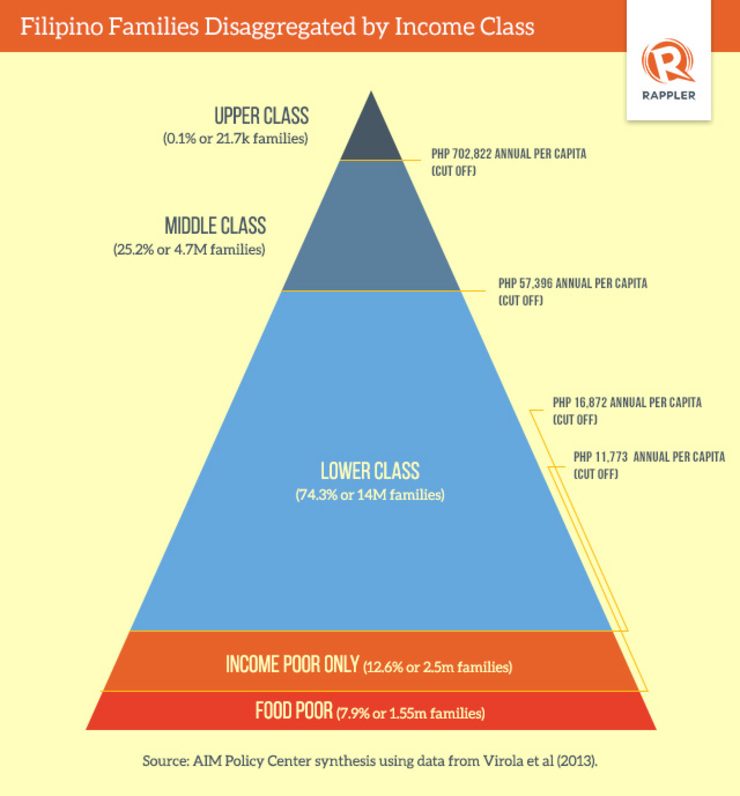
All the foregoing data suggest that the current Congress, like previous Congresses, represent mostly the upper echelon of Philippine society. To this day, the Philippine Congress is not representative of the diversity that exists in Philippine society and reflects instead, only the powerful sections. It doesn’t even represent the majority of the population. It is indeed ironic that the majority of “the people” are young, non-male, and lower class-poor while the “representatives of the people” are old, male, and upper class. While the legislature is technically democratic and pluralist in that its members were chosen, theoretically, through free and fair competition, in reality, its composition is limited to those of the elite. This, to me, is a perversion of pluralism.
(To be concluded)
– Rappler.com
Add a comment
How does this make you feel?
There are no comments yet. Add your comment to start the conversation.